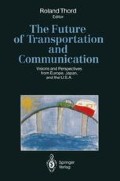Abstract
It is widely believed that environmental effects must increasingly play a dominant role in shaping the transportation systems of the future. If true, this belief has important implications because it suggests a departure from traditional means of evaluating transportation policies. Indeed, this type of argument has been used to justify projects that fail to meet traditional criteria, and furthermore to predict significant changes in personal mobility patterns as they have been shaped by the automobile era. Therefore, it is of interest to examine whether and in what form the belief is true.
Access this chapter
Tax calculation will be finalised at checkout
Purchases are for personal use only
Preview
Unable to display preview. Download preview PDF.
References
Abelson, Philip H. (1990), “The Asbestos Removal Fiasco”, Editorial, Science, 247 (2 March), 1017.
Brajer, Victor, Jane V. Hall, and Robert Rowe (1991), “An Integrated Approach to Benefits Assessment: Attaining Ozone and Particulate Standards”, Contemporary Policy Issues, 9 (1), 81–91.
Cameron, Michael (1991), Transportation Efficiency: Tackling Southern California’s Air Pollution and Congestion. Sponsored by the Environmental Defense Fund and the Regional Institute of Southern California. Oakland, California: Environmental Defense Fund.
Crandall, Robert W., Howard K. Gruenspecht, Theodore E. Keeler, and Lester B. Lave (1986), Regulating the Automobile. Washington D.C.: The Brookings Institution.
Davis, Stacy C., Deborah B. Shonka, Gloria J. Anderson-Batiste, and Patricia S. Hu (1989), Transportation Energy Data Book: Edition 10. Oak Ridge, Tennessee: Oak Ridge National Laboratory. Distributed by U.S. Department of Commerce, National Technical Information Service, Springfield, Virginia.
Giuliano, Genevieve, and Kenneth A. Small (1991), “Subcenters in the Los Angeles Region”. Regional Science and Urban Economics, 21 (2), 163–182.
Gordon, Deborah (1991), Steering a New Course: Transportation, Energy, and the Environment. Cambridge, Mass.: Union of Concerned Scientists.
Haugaard, John (1981), “Measures of Air Pollution Costs Attributable to Motor Vehicle Travel”, Technical Report 134, Institute of Urban and Regional Research, University of Iowa, Iowa City (December).
Jorgenson, Dale W., and Peter J. Wilcoxen (1991), “Reducing US Carbon Dioxide Emissions: The Cost of Different Goals”, Discussion Paper No. 1575, Harvard Insitute of Economic Research, Harvard University, Cambridge, Massachusetts (October):
Krupnick, Alan J., and Paul R. Portney (1991), “Controlling Urban Air Pollution: A Benefit-Cost Assessment”, Science, 252 (26 April), 522–528.
Lave, Charles (1990), “Things Won’t Get a Lot Worse: The Future of U.S. Traffic Congestion”, working paper, Institute of Transportation Studies, University of California, Irvine.
Nordhaus, William D. (1991a), “The Cost of Slowing Climate Change: a Survey”, Energy Journal, 12 (1), 37–65.
Nordhaus, William D. (1991b), “To Slow or Not To Slow: The Economics of the Greenhouse Effect”. Economic Journal, 101 (July), 920–937.
Renner, Michael (1988), “Rethinking the Role of the Automobile”, Worldwatch Paper No. 84, Worldwatch Institute, Washington, D.C.
SCAG (1988): Southern California Association of Governments, “Congestion in the Los Angeles Region: Costs under Future Mobility Strategies”. Paper prepared by the Economic Planning and Development Program. Los Angeles SCAG, March.
Small, Kenneth A. (1977), “Estimating the Air Pollution Costs of Transport Modes”, Journal of Transport Econonics and Policy, 11 (2), 109–132.
Small, Kenneth A. (1991), Urban Transportation Economics. A volume in the Fundamentals of Pure and Applied Economics series, Regional and Urban Economics section. Chur, Switzerland: Harwood Academic Press.
U.S. Congressional Budget Office (1988), New Directions for the Nation’s Public Works. Washington, D.C.: U.S. Government Printing Office.
U.S. Federal Highway Administration (1982), Final Report on the Federal Highway Cost Allocation Study. Washington, D.C.: U.S. Government Printing Office.
U.S. National Council on Public Works Improvement (1988), Fragile Foundations: A Report on America’s Public Works. Washington, D.C.: U.S. Government Printing Office.
Author information
Authors and Affiliations
Editor information
Editors and Affiliations
Rights and permissions
Copyright information
© 1993 Springer-Verlag Berlin · Heidelberg
About this paper
Cite this paper
Small, K.A. (1993). Transportation and the Environment. In: Thord, R. (eds) The Future of Transportation and Communication. Springer, Berlin, Heidelberg. https://doi.org/10.1007/978-3-642-78031-8_16
Download citation
DOI: https://doi.org/10.1007/978-3-642-78031-8_16
Publisher Name: Springer, Berlin, Heidelberg
Print ISBN: 978-3-642-78033-2
Online ISBN: 978-3-642-78031-8
eBook Packages: Springer Book Archive

